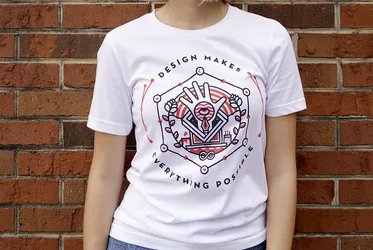
In today’s fast-paced world, where personalization and branding are key, t-shirt logo printing has emerged as a popular choice for businesses, events, and individuals alike. Whether you’re looking to create custom merchandise for your brand or design a one-of-a-kind shirt for a special occasion, understanding the ins and outs of t-shirt logo printing can help you make the best choices. Let’s dive into the fascinating world of this versatile art form.
Why T-Shirt Logo Printing Matters
Tshirt logo printing isn’t just about slapping a logo onto a piece of fabric. It’s about telling a story, building a brand, and making a statement. A well-designed and professionally printed logo on a t-shirt can:
- Enhance Brand Visibility: Walking billboards are real. A logo on a t-shirt is an excellent way to showcase your brand wherever you go.
- Foster Team Spirit: Matching t-shirts with logos can unify teams, whether it’s for corporate events, sports teams, or school groups.
- Serve as a Marketing Tool: Custom t-shirts can double as giveaways or promotional items that keep your brand top of mind.
- Express Individuality: For personal projects, logo printing lets you wear your creativity on your sleeve—literally!
Popular Methods of T-Shirt Logo Printing
When it comes to t-shirt logo printing, there’s no one-size-fits-all solution. The method you choose depends on factors like budget, quantity, design complexity, and fabric type. Here are the most common techniques:
- Screen Printing
- Overview: This classic method involves pushing ink through a stencil or screen onto the t-shirt. Each color requires its own screen, making it ideal for bold, simple designs.
- Pros: Durable, vibrant colors, cost-effective for bulk orders.
- Cons: Not suitable for intricate designs or small batches.
- Direct-to-Garment (DTG) Printing
- Overview: Think of it as a giant inkjet printer for fabric. DTG allows for high-resolution, full-color designs.
- Pros: Perfect for complex and detailed logos, no minimum order requirement.
- Cons: Slower process, less durable compared to screen printing.
- Heat Transfer
- Overview: This method uses heat to transfer designs from a special paper onto the t-shirt.
- Pros: Affordable for small batches, versatile.
- Cons: Less durable, especially after multiple washes.
- Vinyl Printing
- Overview: A vinyl cutter creates the design, which is then heat-pressed onto the fabric.
- Pros: Durable, great for text-based designs and small quantities.
- Cons: Limited color options, not ideal for detailed graphics.
Choosing the Right Material for Your T-Shirt
The quality of your t-shirt is just as important as the printing method. After all, even the best logo can fall flat if the fabric isn’t up to par. Here’s a quick guide:
- Cotton: Soft, breathable, and versatile, cotton is a top choice for comfort and durability.
- Polyester: Known for its moisture-wicking properties, polyester is ideal for athletic wear.
- Blends: A mix of cotton and polyester combines the best of both worlds, offering comfort and durability.
- Specialty Fabrics: If you’re aiming for a premium feel, consider tri-blends or organic cotton.
Tips for Designing a Standout Logo for Printing
Before you print, you need a design that works well on fabric. Here are some expert tips:
- Keep It Simple: While intricate designs are impressive, simpler logos often translate better onto t-shirts.
- Choose the Right Colors: Use high-contrast colors to make your logo pop. Keep in mind the color of the t-shirt when selecting your palette.
- Test for Scalability: Your logo should look great at any size, whether it’s a small chest print or a full back design.
- Consider Placement: The most common placements are the chest, back, and sleeves. Choose a spot that aligns with your purpose and audience.
Balancing Cost and Quality
Budget is a key factor in t-shirt logo printing, but it shouldn’t come at the expense of quality. Here’s how to strike the right balance:
- Order in Bulk: Most printing methods offer discounts for larger orders.
- Opt for Simpler Designs: Reducing the number of colors or design elements can cut costs.
- Choose the Right Method: custom logo t-shirt printing is often the most cost-effective for large batches, while DTG is better for small orders with detailed designs.
Sustainability in T-Shirt Logo Printing
As sustainability becomes a growing concern, many printers are adopting eco-friendly practices. Here’s how you can make environmentally conscious choices:
- Use Organic Fabrics: Organic cotton and recycled materials reduce environmental impact.
- Opt for Water-Based Inks: These are less harmful than traditional plastisol inks.
- Work with Ethical Printers: Many companies now prioritize fair labor practices and sustainable production methods.
How to Find the Right T-Shirt Logo Printing Service
Choosing the right service provider is crucial to achieving the results you want. Consider the following:
- Portfolio and Reviews: Look at past projects and customer feedback to gauge quality.
- Turnaround Time: Ensure the provider can meet your deadlines, especially for time-sensitive events.
- Customization Options: Some printers offer additional services like design assistance or specialty inks.
- Price Transparency: Make sure there are no hidden fees and that you’re getting value for your money.
FAQs About T-Shirt Logo Printing
Q: What’s the best printing method for intricate designs? A: Direct-to-garment (DTG) printing is ideal for detailed and colorful designs.
Q: Can I print on dark-colored t-shirts? A: Absolutely! However, some methods, like DTG, may require a white underbase to make the colors stand out.
Q: How long does the printing process take? A: Turnaround times vary by provider and method, but most orders are completed within 1-2 weeks.
Q: Are there eco-friendly printing options? A: Yes, look for printers that use organic fabrics, water-based inks, and sustainable practices.
Q: Can I wash printed t-shirts in a machine? A: Yes, but it’s best to turn the shirt inside out and use cold water to preserve the design.